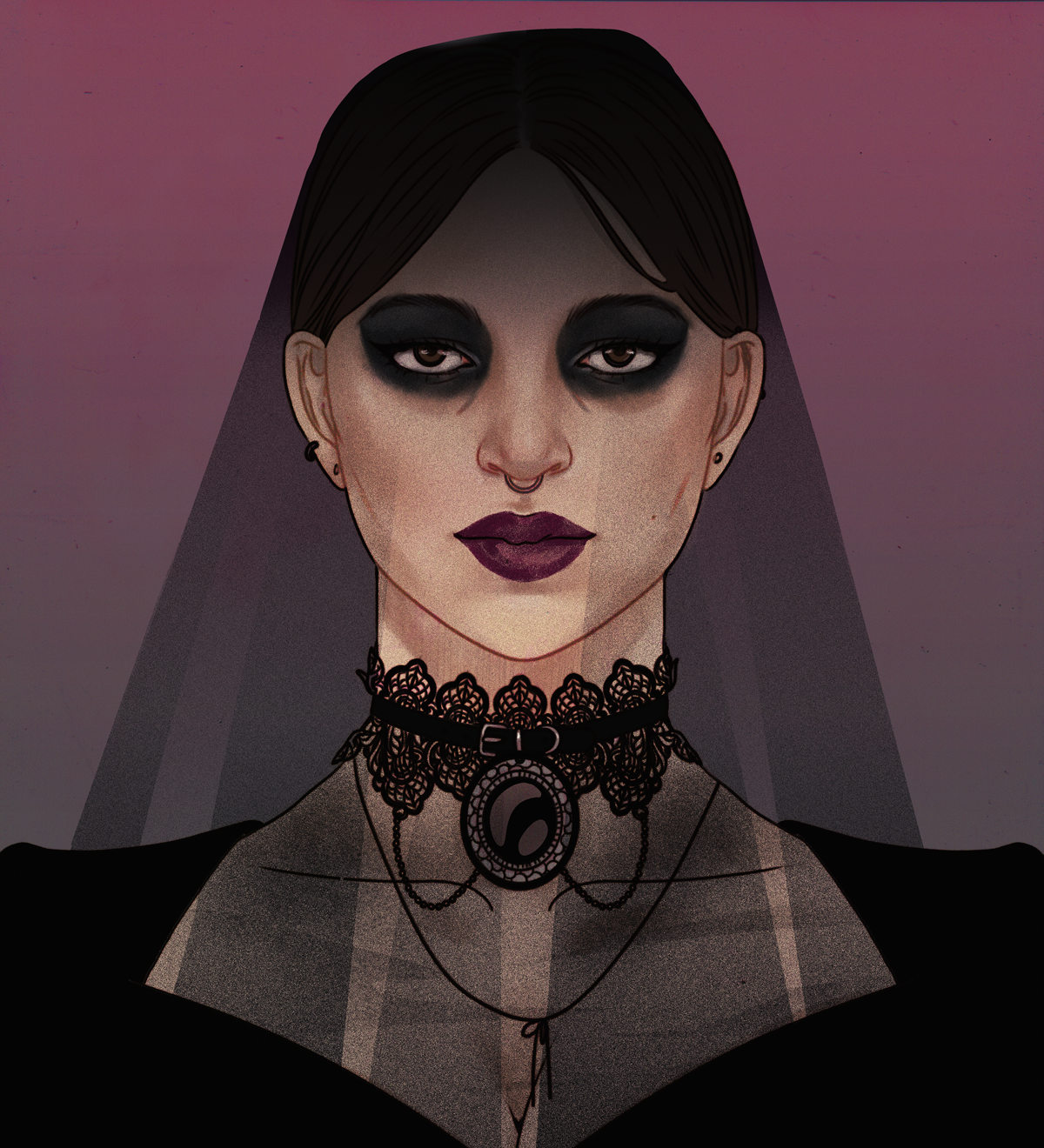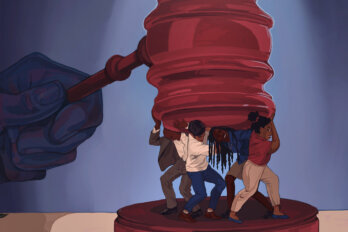After the death of her husband, Prince Albert, in 1861, Queen Victoria was so elaborate in her sartorial choices that she inspired the goth style that persists today. Not only did she enter a period of sustained seclusion, rarely appearing in public for decades, but she also wore only black until her own death, forty years later. It was a lavish darkness, taking the form of sheer veils and extravagantly layered dresses of velvet, silk, and satin, which billowed around her like a cloud. A waist-length jacket, which she often wrapped around herself and buttoned all the way to her chin, signalled that her heart was closed for business. She haunted the halls of Buckingham Palace like a spectre of grief. Death became her—as it did for many in the Victorian era.
Following the queen’s example, black mourning dress became popular and were worn anywhere from three months to two and a half years after a loved one’s death. Magazines and manuals provided detailed instructions on how to style oneself in grief, and some shops exclusively sold mourning attire. It didn’t end with fashion: while grieving, Victorians would drape their homes in darkness, keeping their curtains drawn at all hours the day and night. Upper-class funerals were elaborate affairs, with enormous monuments flanking gravestones and processions of hearses, horses, and coaches. Women were known to throw themselves over coffins, howling the name of the deceased. This penchant for darkness, or memento mori (Latin for “remember you must die”), pervaded Victorian culture, from literature, where stories of the undead reigned supreme, to architecture, where the cavernous and imposing prevailed.
“The Victorians were death obsessed,” says Carol Margaret Davison, editor of Anthem Studies in Gothic Literature and a professor at the University of Windsor. “This was primarily because of increasing anxiety about the existence of an afterlife.” On top of Victorians’ anxieties about God and the queen, disease and death were rampant. It wasn’t unusual for entire families to be obliterated by tuberculosis, cholera, scarlet fever, yellow fever, or the Russian flu. There was no other option but to embrace death and find beauty through the fear and loss.
It’s a sentiment that, in 2022, feels familiar. We may not be walking around in black veils, but COVID-19 has been a forceful reminder of our mortality. Since the start of the pandemic, more than 6 million people have died. Reminiscent of the nineteenth century, mass graves have appeared in Italy and New York. Depression and anxiety rates are higher than they’ve ever been, with the World Health Organization reporting a 25 percent increase since the start of the pandemic. We’re living in what feels like a state of constant impending doom, and much like the Victorians, it’s defining a new gothic era.
It wasn’t until the twentieth century, when the advancement of medicine allowed for treatment in hospitals, that the Victorian embrace of mortality began to fade. In the years prior, people often died in the home, able to say their last words surrounded by family. A more medicalized process, however, created a wall between life and death. Suddenly, dying was an isolated event—something that normally happened under the supervision of nurses and doctors. As new treatments became available for conditions that were once incurable, death began to feel more like a problem to be solved than an inevitability. Since the Victorian era, the average life expectancy has nearly doubled, and attitudes toward death have shifted. “We have entirely sanitized it and rendered it invisible wherever possible,” explains Davison. This extends to the ways in which we mourn. While funerals used to be grand days-long affairs, they’re now usually smaller and more quietly sombre.
But, over the past two years, death has once again taken centre stage. “So many of the people who have been dying over the past year, whether from the pandemic or through hate crimes, they are dying in front of us and we can’t turn away and ignore it now,” says Deborah Lutz, a professor of Victorian literature at the University of Louisville. She adds that, recently, conversations surrounding not only death but race and inequality—including everything from the Black Lives Matter movement to the annual women’s marches that take place all over the world—have only gotten louder, culminating in a modern gothic resurrection that merges the morbidity of the Victorian era with the rebellion that defined the subculture in its initial 1970s revival.
When most people think of goths, some combination of dark clothes, black nail polish, morbidity, and surliness likely comes to mind. What it really means to be a goth, however, goes beyond aesthetics. Taking root in Britain, ’70s goth culture was a rejection of the health-conscious conservative mainstream—fad diets, neon-tinted aerobics classes—that took hold after Margaret Thatcher was elected. Because conservatism was spreading and racial tensions remained high, it was a time that triggered pushback, eventually sparking the women’s rights and gay liberation movements.
As rebels, goths of the era expressed dissent through not just what they wore—from harnesses to fishnets to Victorian-inspired collars and drapery—but what they stood for. They opposed the status quo by rejecting indifference and ignorance and by embracing the harsher realities. As David Lenson wrote in the 2007 essay collection Goth: Undead Subculture, “The mating of angst and aesthetics is standard fare; it may be that for some goths their expulsion triggers a confluence of art and anger, a stance inherited from punk.”
This new gothic attitude proliferated in the ’80s and through to the ’90s, when the internet provided a space above the underground where people could easily find communities—along with aesthetic inspiration. Today, the internet remains a haven for modern goths, with #goth garnering nearly 11 billion views on TikTok. Between 2019 and 2022, the goth forum on Reddit jumped from 19,000 subscribers to over 100,000.
While the latest iteration of the goth still champions rebellion, it’s just as much about acceptance. This translates to film and television too. Cruella de Vil and Wednesday Addams—the original fictional poster girls of the macabre—first appeared on screen in the 1960s. They’ve since become feminist icons and have grown increasingly rebellious in Disney’s 2021 live-action remake Cruella and Tim Burton’s upcoming Netflix series Wednesday, respectively. In the way they wear and speak their darkness, both characters are liberated from inhibition. In their original iterations, this disinterest in conforming made them outsiders. Today, they’re positioned as icons—their anarchy so loud and exaggerated that we celebrate it. Their appeal may be partly nostalgic, but it also resonates with the present day.
Now, two years and millions of deaths into this relentless pandemic, it feels like we’ve been given a fresh awareness, forced to face mortality in ways many of us never have before. The Victorians, it turns out, were onto something: there is relief to be found in acceptance of the end, and resistance to death only breeds greater fear. As Victorian poet Charles Baudelaire wrote in “Death of the Poor,”
It is the goal of life, and it is the only hope,
which, like an elixir, uplifts and intoxicates us
and gives us the heart to walk until night.
Difficult as they may be, our current times offer us an overdue opportunity to gain a deeper understanding of death. Indulging in goth culture can be a way to reckon with life’s transience and mystery without losing the nerve to stand up to injustice.





